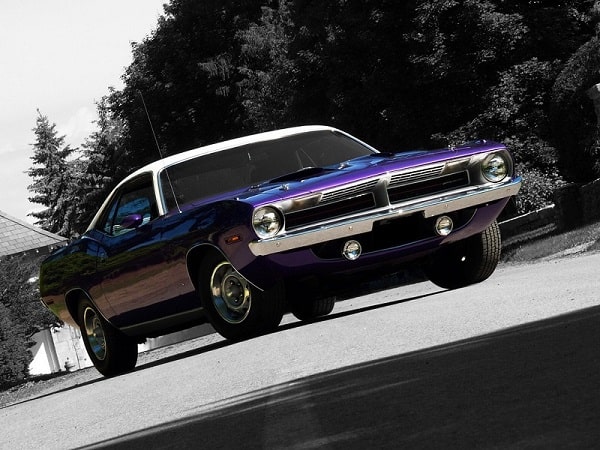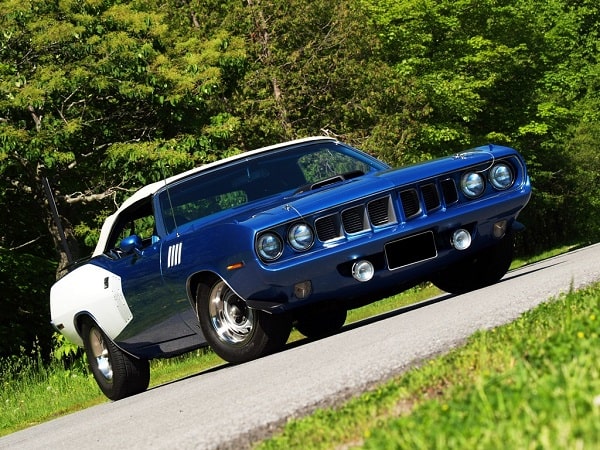
Car owners: Diane Guindon and Claude Lozier Words & photos: Clive Branson
In the USA, gasoline cost a mere 35¢ per gallon, the median household income was just under 10 grand, while the prime rate was a whisker above five percent and a generous 30-year fixed rate mortgage went for 7.25 precent. On the street level, cars flexed their muscle and were considered by their owners as more than simple tools of transportation, transforming boulevards across the nation into catwalks and drag strips.
It was 1970, and everything seemed perfectly set up for muscle car enthusiasts until the government passed the Clean Air Act to protect the ozone layer and promote public health by reducing auto emissions and, as a result, the exuberance of power. Though this was something of a setback to the current auto racing community, no one could predict what was coming.
The fast and furious were key targets by insurance companies, which increased their policy rates to an amount equivalent to a muscle car’s monthly payment. As the oil crisis became a salient point, the congestion at gas stations began to thicken as the public’s frustration at being enslaved to OPEC tyrants grew. They spoke with their wallets and bought smaller, more economic cars, particularly from foreign countries that knew how to build smaller, more economic cars. America’s metal metaphors had become an endangered species, as had their massive engines.
Diane Guindon and her husband, Claude Lozier, own two Plymouth Cuda convertibles from the early ‘70s. Though the cars are 50 years old, they are in mint condition and look like they belong in a centerfold. Diane’s 1970 Cuda has the colour reminiscent of a purple popsicle, called Plum Crazy. The car is a former street racer that, when unleashed in its day, spewed out the bellow of a V8 from a 440 Six Pack controlled by a 410 Dana gear.
“I purchased the car in 2016. The Cuda had 53,000 miles on it but had been stored in a chicken coop for some years.” In the 1980s, the previous owner’s father restored the car back to its factory standards, but instead of housing the mighty 440, block he replaced it with a 1969 workaholic 383-cubic inch (6.28-liter) big block with 300 hp to mirror the manufacturer’s original specifications.
“We boosted the battery, started the car and managed to drive it out of the chicken coop, but it needed some TLC. I changed the carpet, the gas tank, gas line and the carburetor. The worst part was the number of mice nests found in the car when inspected by a mechanic. I was driving the car on a hot summer day and decided to open the bottom vents to get some fresh air. To my horror, instead of cool air, I got the remains of a dried out nest on my clothes, hair and face. Fortunately it was empty of any residents.”
The 1970 version of the Barracuda was so different from its fastback predecessor it looked like it spoke a different language. This was a totally new incarnation stylized by auto maestro John E. Herlitz and unashamedly aimed at hardcore street racers. Even the name, “Cuda,” was cool. Plymouth advertised it provocatively as “The Rapid Transit System.” Instead of the usual Chrysler’s A-platform, Plymouth used the shortened B-platform (called the E-body). What emerged was something akin to unadulterated fruit. There was nothing like it in the American market: curvaceous lines, beautifully balanced (the short trunk compensated for the long hood), taut, pleasingly wider and uncluttered with tapered-in bumpers, concealed wipers, flush door handles, smooth overhangs, and subtly flared wheel arches. The car oozed with sex appeal and power to burn.
To emphasize the power, a noted car magazine claimed: “To optimize the power band, shift the transmission when the engine reaches 5,000 rpm. The Cuda jolts off the line and pulls extremely hard, even in 383 guise.” Though it was compared to the similar looking Dodge Challenger, no exterior sheet metal interchanged between the two cars and the Challenger, at 110 inches, had a wheelbase that was two inches longer than the Cuda. Customers could have their selection of nine engine options, topped by the outrageous 426 cid Hemi.
“This car is a good investment,” declares Diane. “In a way, this car makes a statement and represents a certain amount of success. It’s definitely an exhilarating experience every time I sit behind the wheel.” This is a car that flirts with you. What could be better but to be completely seduced by the ’71 model?

Plymouth revised the front end of the Barracuda for 1971, adopting a more menacing grille with six “venturi” air inlets, quad headlights, a host of “catch-me-if-you-can” add-ons including the shaker hood scoop, rear spoiler and wild “billboard” bodyside stripes that called out engine size. Most of the “High-Impact” palate of eye-grabbing extra-cost colours remained on the options shopping list. Under the hood lay a display of power: the 340, 383, 440 and the 426 Hemi.
This wasn’t entirely the case for Claude’s ’71 Cuda, since he first saw it when it was completely disassembled. Actually, when he first saw a Barracuda he was 12 years old. “I remember the first encounter of a ’71 Cuda,” recalls Claude, “when my dad had a new two door Bel Air and, like a bat out of hell, an orange hardtop Cuda roared by. The two guys in the car had long hair and mutton chops, but the car was so outlandish as it disappeared out of view.”
After an exhaustive 18-month search throughout North America, Claude still couldn’t find a Cuda within his budget. Ironically, a 383 Cuda was lurking locally, albeit in pieces. “The owner had started the restoration, but due to his failing health he had to sell the project,” explains Claude. “The car was bought during the notorious ice storm of 1998 and since the car was dismantled, it was brought in several trips over a few hours. The body of the Cuda was on a flat bed truck and nearly slid into a gulley. I stored the car in our townhouse garage with all the parts, so you can imagine what a tight squeeze it was.”
Claude approached the owner of ASE with the restoration proposal and was given the nod, especially when ASE considered the rarity of the model. “We restored everything!” says Claude emphatically. “The entire car took over 2,300 hours to bring back to life, including repainting it the original duatone colours. Though the car drives like mayhem under control, I am filled with pride to have such a rare, beautiful and powerful car. It was a long road and sacrifice to bring this car to its present state. I am so grateful for the countless people who helped us with parts, manpower and more. What is truly wonderful is that I can share the magnificence of this car with so many admirers.”
Claude was lucky to get his hands on a ’71 model, for it was considered the swan song for the brand. Chrysler set its target sales on the youth/performance car market estimated to number as much as 15 percent, or 1.5 million cars. The auto manufacturer set its target at 200,000 units between the Barracuda and the Challenger, but the expectation was as apparently overambitious as Evil Knievel missing his landing over the Grand Canyon. Only 55,499 Cudas sold (falling by 66 percent) and 83,032 Challengers. Executives and managers were desperate to cling on to their jobs as the hatchet fell. The Barracuda lost its swagger from tightening government belts regarding emission regulations as well as the rising costs of gas and insurance rates.
Yet the Cudas are some of the most sought after pony cars in American automotive history, some fetching well into the six-figure and higher figure range. Claude collects his thoughts before he elaborates. “The market is red hot for any Cudas, though some have fallen a bit in price. The classic cars of the ‘80’s and ‘90’s are few, so people are falling back to the cars of the muscle era. The young crowd are not as enthusiastic, but it is a matter of what one likes.”
Diane shares a different prophecy. “My father and uncles played a large role in shaping my love of cars. I am fortunate that my husband also shares my passion for cars. Unfortunately, I think muscle car enthusiasts are a dying breed. There are very few young people who appreciate them. Unlike us, they didn’t grow up with those types of cars. They don’t really relate to them like we do.” It may be said that there are no chequered flags in the real world; however, those who experience the ownership of a Cuda know they are in an elite group.











